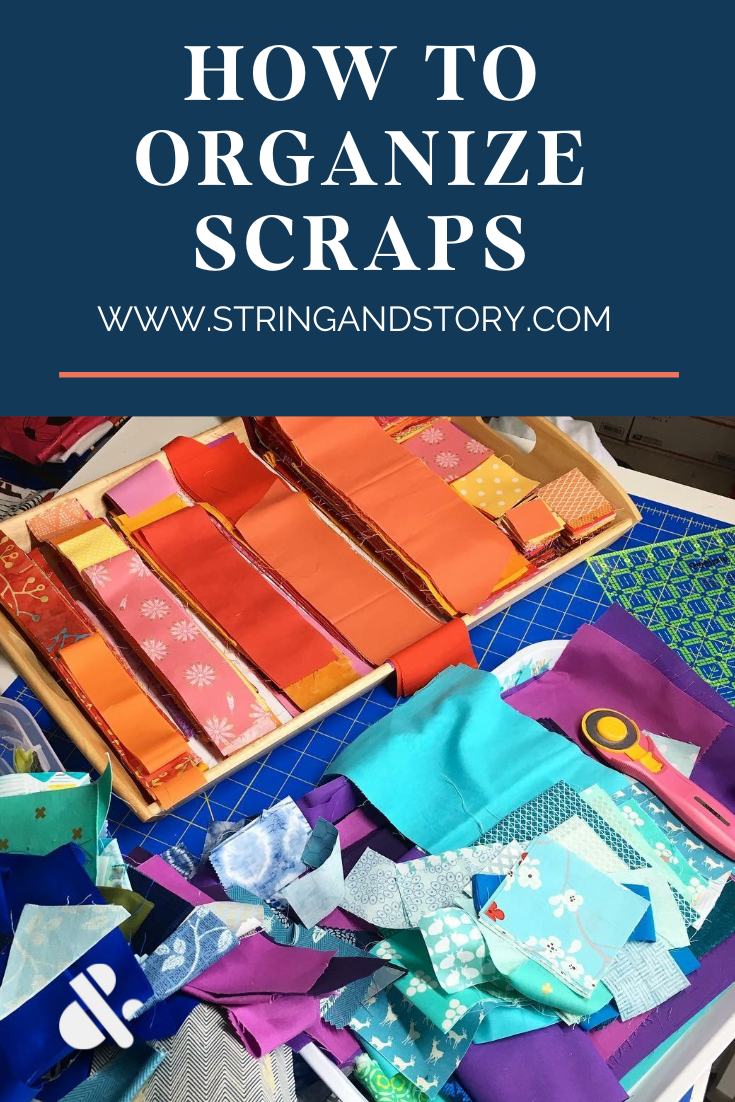How to Organize and Store Scraps
Scraps happen, and sometimes it seems like they multiply when we're not looking-- like little linty rabbits hiding in bins, baskets, and jars all over our sewing rooms. Learn how to tame your collection and give it a job, turning an inconvenience into gorgeous scrappy quilts.
(This post contains affiliate links)
Even without a plan for them, we quilters tend to keep our scraps. We intuitively know that they are more fabric than we think and that they contain a lot of potential. Instead of letting them languish, let's look at two primary ways to store scraps.
Untrimmed Scraps
If you're a fan of made fabric a la Victoria Findlay Wolfe, improv piecing a la Sherri Lynn Wood or Cindy Grisdela Quilts, or foundation paper piecing , then you may prefer to keep your scraps untrimmed, simply sorted by color.
The most important decision for this method is to decide how small you’re willing to keep. Dedicated scrap users will sometimes keep pieces as small as 1” square. Increasingly, as a sporadic scrap user, I’m reticent to keep anything smaller than 2” square.
(Read more about this in my follow up post: How to Use Scraps)
Bonnie Hunter's Scrap User's System
According to her blog, Bonnie originally thought of calling it the "Scrap Saver's System," but with her usual insightful attention to language, Bonnie realized that she would rather call it the "Scrap USER'S System" (emphasis added) because she wants it to be a tool that gives our scraps a job.
Bonnie trims her scraps to a variety of sizes of squares, bricks, and strips (made from anything at least 12" long) and stores them, sorted by color and size, in plastic zippy bags inside drawers under her long arm. If you are unfamiliar with her system, I encourage you to read all the details on her blog and/or read the lovely summary in the introduction of Addicted to Scraps.
I don't particularly love cutting, so when I first heard of Bonnie’s system, it mostly sounded like a lot of work! Then, I had the delight of hearing Bonnie lecture, and as she taught about scraps and piecing and efficiency, and as I saw all her quilts, it started to click. If I focus on the big ol' quilt I want to make, I'll get overwhelmed. Instead, scraps turn into pieces, pieces into units (often stitched together as leaders and enders), units become blocks, and blocks become quilts. Voila!
Because I rarely do anything "as directed," I modified Bonnie's system a little bit when I started cutting down my scraps:
Note bene: I’m a fickle follower of this system at best because of the way I sew for the shop, etc. But I LOVE the concept, and I’ve really enjoyed the projects I’ve made from these prepared scraps
1) I don't cut bricks. I don't feel like I use them all that often, I can always cut them out from strips, and they didn't fit on my pretty tray
2) I do still cut 3" strips and blocks because a few patterns I've had my eye on lately call for them. Plus, I can always abandon this size later if I find that I don't actually use it.
3) I keep my scraps on trays on my bookshelf. I am VERY much an "out of sight, out of mind" kind of person, so having my scraps where I see them daily gives me no excuse not to be feeding them through my machine as leaders and enders, even if I'm just making four patches or HSTs. Plus, again, I want to limit my scrap stash the same way I limit my yardage stash. If the stacks start to tumble or overflow from the trays, I know I need to get to sewing!
As a result, I'm excited to see my sewing room becoming more orderly AND I'm making awesome progress on my first leaders and enders quilt made from bonus triangle pinwheels, four patches, and solid squares.
Chat with Us!
Who better to learn about scraps from than the master herself! Join me and Bonnie on my String & Story Facebook Page -- catch the replay here:
The bottom line, save what you will use and release the rest.
Resources
FREEBIE: Scrap Friendly Good As Pie Placemat Pattern
BLOG: Summer Stash Busting 2023 full lineup
BLOGS: A lot of folks are unsure about mixing prints together. I wrote an entire series on choosing fabrics and working with prints that you can check out here
BLOG: If you’re afraid of your scrappy quilts looking like fabric puke, check out my favorite tips for making any pattern scrappy (and loving it) here.
PS Don't forget to pin this post so you can find it later!
Share this blog if you found it helpful:




